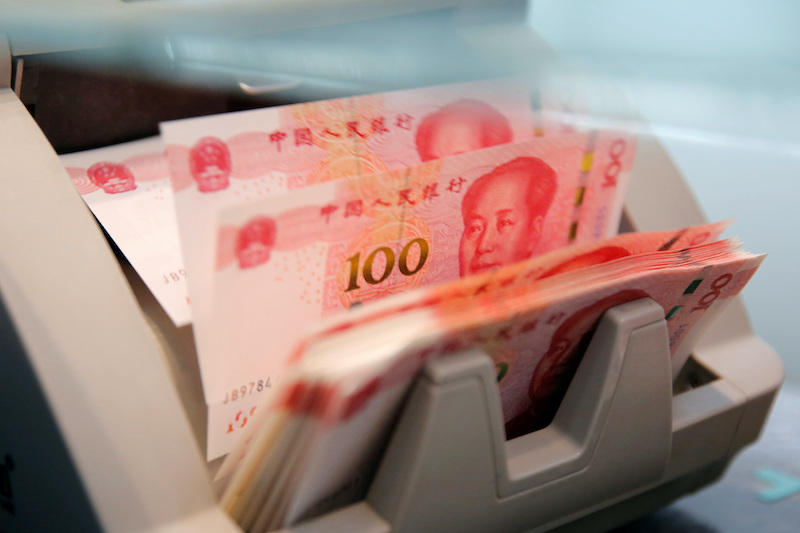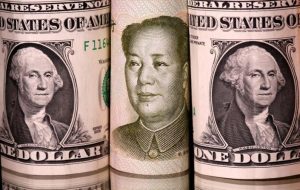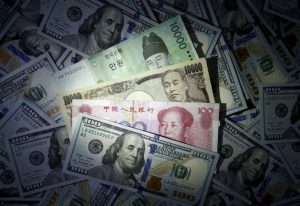Beijing is suspected of being behind a controlled decline in the yuan in a bid to smooth the way for easier monetary policy and to boost Chinese exports and lift its wider economy.
The yuan has declined roughly 2% this year against the dollar but has become relatively less competitive as Japan’s yen and currencies of other neighbours South Korea, Thailand and Taiwan drop more sharply.
Investors believe, though, the People’s Bank of China (PBOC) has loosened its grip on the yuan, allowing it to fall to the weak side of the 7.2-per-dollar level that state-owned banks have staunchly defended in the past, though it has continued to lend some support through stronger-than-expected settings of the daily mid-point for the currency.
Also on AF: Shimao Bondholders Group to Vote Against Debt Revamp Plan
Last Friday, traders took the absence of state banks in the market to push the yuan to 7.23 to a dollar initially, and even though state banks eventually stepped in, the yuan saw its biggest daily drop in nearly 3 months.
Analysts at National Australia Bank (NAB) said it was “more than coincidental” that the PBOC’s defence of the yuan had relaxed in the same week the Bank of Japan abandoned its negative rates and yield-curve control policy.
Though the BOJ’s policy shift last week was momentous, Japanese yields are still barely positive and the yen has ironically weakened further. It is down 7% this year against the dollar this year alone, and at a 30-year low against the yuan.
“Concerns at loss of export competitiveness vis-à-vis Japan too have motivated Friday’s decision to lift the 7.20 cap,” NAB analysts Ray Attrill and Rodrigo Catril wrote this week.
The yuan’s trade-weighted index is up 2% so far this year as currencies of China’s trading partners have weakened, gnawing away at the country’s export competitiveness and hobbling its uneven economy recovery.
The index is at 99.30, far above the 92-98 band that analysts think the PBOC is comfortable with.
Even though China’s exports seem to have rebounded early this year, the manufacturing sector is struggling, and weak export orders suggest the sector needs more support. A weak yuan would help lift export earnings.
Analysts at Oxford Economics expect the monetary policy divergence between the US Federal Reserve and PBOC to keep the yuan weak in the first half of 2024, but wrote that “any depreciation ahead is likely to be highly controlled”, and projected the yuan will not fall beyond 7.34, a level last seen in September.
Mainland Stock Outflows
UBS strategists Rohit Arora and Teck Quan Koh also reckon there could be a shift in Beijing’s policy priorities, similar to the yuan’s decline in the second half of 2022, when it gradually fell nearly 9% to as far as 7.328.
“Put another way, we don’t expect authorities to allow yuan to be fully market-driven, but continue with a managed and orderly adjustment process,” they said.
Barring another big boost for the US dollar, they expect the yuan will head slowly for 7.4.
Indeed, the steady outflows from frail mainland stock markets and other speculative bets might require the PBOC to dampen volatility, as it does normally through state banks.
One such pressure point is the yuan’s increasing use in ‘carry trades’ in which investors borrow in a currency with low interest rates and invest the proceeds in a higher-yielding currency.
Returns on yuan-funded carry trades are lower than that on yen-funded ones, where an easy 5% annualised gain can be made on 3-month swaps. But traders expect the yen to be more volatile under the BOJ’s new policy regime, while the yuan has traditionally been sheltered.
“From where I sit, the only thing preventing the yuan from meaningfully weakening is active policy guidance from PBOC,” said Rong Ren Goh, a portfolio manager in the fixed income team at Eastspring Investments.
- Reuters with additional editing by Sean O’Meara
Read more:
Rupee Plummets to Record Dollar Low, Yuan Pressure Blamed
China Banks Move to Stabilize Yuan as Stock Markets Slide
China’s Yuan Topples Dollar as Most Traded Moscow Currency
China State Banks’ Yuan-Buying Push ‘Hints at Rate Cuts’
























